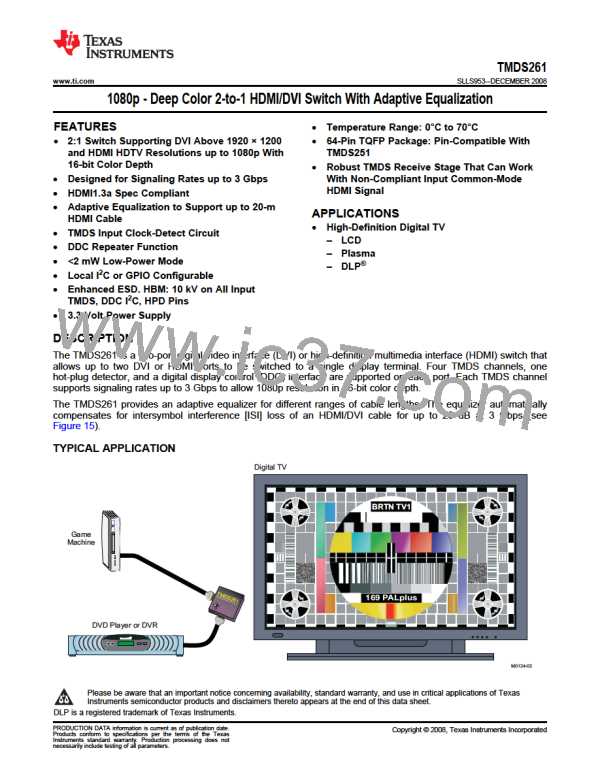TMDS261
SLLS953–DECEMBER 2008............................................................................................................................................................................................ www.ti.com
in different DTVs with different consumer electronic control (CEC) requirements. The CEC is an optional feature
of the HDMI interface for centralizing and simplifying user control instructions from multiple audio/video products
in an interconnected system, even when all the audio/video products are from different manufacturers. This
feature minimizes the number of remote controls in a system, as well as reducing the number of times buttons
must be pressed.
A DTV Supporting a Passive CEC Link
In Figure 34, the DTV does not have the capability of handling CEC signals, but allows CEC signals to pass over
the CEC bus. The source selection is done by the control command of the DTV. The user cannot force the
command from any audio/video product on the CEC bus. The selected source reads the E-EDID data after
receiving an asserted HPD signal. The microcontroller loads different CEC physical addresses while changing
the source by means of the S1 and S2 pins.
E-EDID Reading Configurations in Standby Mode
When the DTV system is in standby mode, the sources do not read the E-EDID memory because the 1-kΩ
pulldown resistor keeping the HPD_SINK input at logic low forces all HPD pins to output logic-low to all sources.
The source does not read the E-EDID data with a low on HPD signal. However, if reading the E-EDID data in the
system standby mode is preferred, then TMDS261 can still support this need.
The recommended configuration sequences are:
1. Apply the same 3.3-V power to the VCC of TMDS261 and the TMDS line termination at the HDMI receiver
2. Because the TMDS261 has clock-detect circuitry and there is no valid input TMDS clock in the standby
mode, TMDS261 draws significanty less current.
3. Set S1 and S2 to select the source port which is allowed to read the E-EDID memory.
Note that if the source has a time-out limitation between the 5-V and the HPD signals, the foregoing configuration
is not applicable. Uses individual EEPROMs assigned for each input port, see Figure 35 through Figure 37. The
solution uses E-EDID data to be readable during system power-off or standby-mode operations.
SINK
VDD
(5V)
VCC
(3.3V)
HPD
5V
HPD
5V
HPD1
5V
47kW
EQ
mController
SDA1
SCL1
S1
S2
SDA
SCL
CEC
SDA
SCL
CEC
SOURCE 1
CEC
A21/B11
A22/B12
A23/B13
A24/B14
CLK
D0
D1
D2
CLK
D0
D1
D2
HPD_SINK
1kW
3.3V
4.7kW
4.7kW
HPD
5V
HPD
5V
DDC_SDA
DDC_SCL
HPD2
SDA_SINK
SCL_SINK
5V
47kW
E-EDID
SDA2
SCL2
SDA
SCL
CEC
SDA
SCL
CEC
HDMI RX
SOURCE 2
CEC
Y1/Z1
Y2/Z2
Y3/Z3
Y4/Z4
Y1/Z1
Y2/Z2
Y3/Z3
Y4/Z4
A21/B21
A22/B22
A23/B23
A24/B24
CLK
D0
D1
D2
CLK
D0
D1
D2
VSadj
GND
4.02kW 10%
Figure 34. Two-Port HDMI-Enabled DTV With TMDS261 – CEC Commands Passing Through
28
Submit Documentation Feedback
Copyright © 2008, Texas Instruments Incorporated
Product Folder Link(s) :TMDS261

 TI [ TEXAS INSTRUMENTS ]
TI [ TEXAS INSTRUMENTS ]